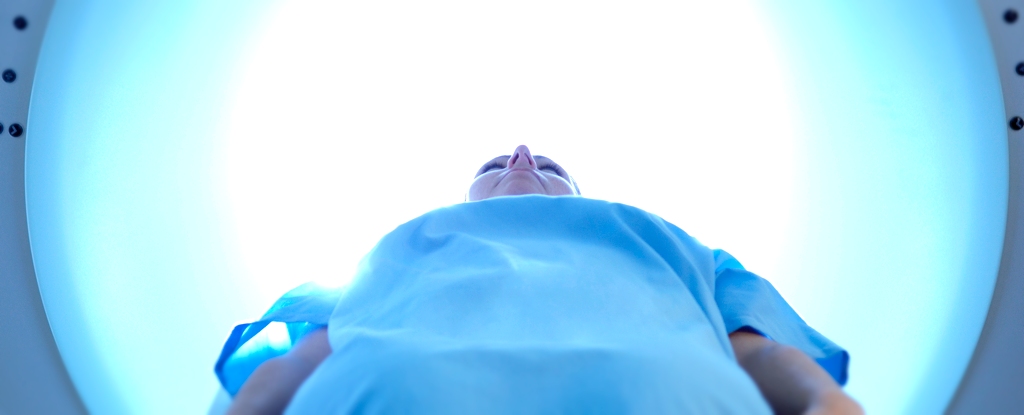A 57-year-old woman from Wisconsin recently sustained a rather unfortunate injury to her buttock. She had attended the hospital for an MRI ( magnetic resonance imaging) scan and had entered the machine with a concealed firearm. The machine’s powerful magnet caused the gun to discharge.
This isn’t the first time in 2023 that a firearm injury has been sustained in an MRI scanner. In February a lawyer in Brazil died after the gun tucked in his waistband discharged into his abdomen.
MRI has a long history, in one form or another, dating back to the 1930s. Many years of studying and adapting led to the first patient scan occurring in 1977.
Around 95 million MRI scans are performed every year. It is an effective and valuable diagnostic tool, which is incredibly safe for patients (when patients follow guidelines) giving excellent tissue resolution in diagnostic images and not exposing the recipient to any harmful ionising radiation.
While it is safe, there are some concerns from patients about the noise the machines make (earplugs are offered), which can reach 100 decibels. And some people with claustrophobia struggle to tolerate long periods in the machine.
MRI works by applying powerful magnetic fields to whatever is being imaged. These magnets produce a magnetic field that is 30,000 stronger than that of the Earth.
The protons (subatomic particles) that make up every element in the body (and universe) are excited, causing them to move out of their normal relaxed state.
When the magnet is turned off, the sensors of the machine detect the released energy from the protons as they return to their resting state. This enables scientists to tell the difference between types of tissue and whether they are healthy.
Strong magnets
One of the biggest risks with MRI comes from the incredibly strong magnets that are used because they are not selective in the objects they act on.
They can pull metallic objects into the field from anywhere in the room, as seen with the previously mentioned firearm incidents, or do damage by heating the items while in or against the body, causing burning.
For this reason, there are strict guidelines for MRI scans, with patients having to undergo a pre-scan questionnaire relating to medical history and potential metallic objects to prevent injury or death.
People with pacemakers or other implanted electronic devices used to be particularly at risk of harm. However, special procedures have been put in place to support people with these implanted devices being scanned. Also, newer models tend not to contain ferrous metals – that is, metals that can be attracted by magnets because they contain iron.
People with foreign metallic bodies located within them are also at high risk. A 65-year-old man with schizophrenia who had ingested metal sockets and a hinge pin had his stomach ripped open while undergoing an MRI.
Similarly, a child suffered bowel perforation during an MRI after ingesting 11 small spherical magnets.
Another risk is the formation of a so-called “tissue loop” where one piece of the body is in contact with another creating a loop that heats the tissue to burning point.
Examples include parts of the upper thigh contacting each other, hands coming together and other points where one piece of skin is in contact with another. These are uncommon but are mitigated by getting people to lie in certain positions to ensure a safe scan.
Outside the machine can be dangerous too
Hospitals and clinics have measures in place to limit the proximity of metallic objects to the MRI suite – but, on rare occasions, these aren’t followed.
In 2018, an Indian man was killed when an oxygen cylinder he was carrying was pulled into the MRI machine, causing it to rupture and kill him.
Similarly, in 2021, a South Korean man died when an oxygen cylinder in the MRI room crushed his skull after the magnet pulled it into the machine he was being scanned in.
One of the greatest unknown risks comes from bits of metal lodged in the eye. This is typically a problem among manual labourers and military veterans, where hammering, chiselling, drilling or shooting or explosions may have caused microscopic metal shards to become lodged – often unknowingly – in the person’s eye.
These small pieces of metal can become dislodged or twist to align with the magnetic field during MRI scanning, leading to bleeding in the eye, excruciating pain and blindness.
Benefits far outweigh the risks
Despite the above stories, MRI is a revolutionary diagnostic machine that has benefits that far outweigh the risks.
Further modifications of MRI, such as fMRI (functional MRI), let doctors and researchers look at brain activity and observe how diseases, such as Alzheimer’s, are progressing. They are also helping researchers discover new drugs and study anatomy – including during sex and orgasm.
These revolutionary machines are extremely useful and are entirely safe when used correctly.
So next time you have an MRI scan, when clinical staff ask what seems like innocent and straightforward questions, answer honestly. And tell them about anything you think may be relevant, no matter how trivial, just to be on the safe side.![]()
Adam Taylor, Professor and Director of the Clinical Anatomy Learning Centre, Lancaster University
This article is republished from The Conversation under a Creative Commons license. Read the original article.





